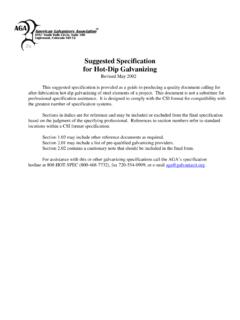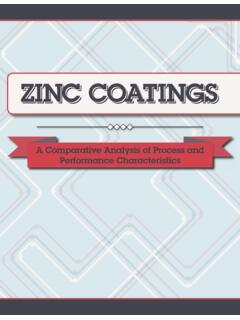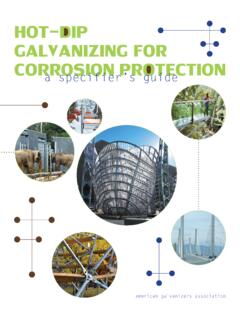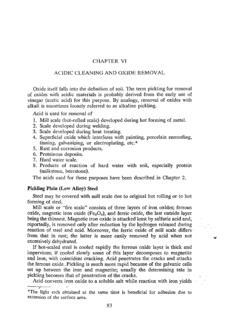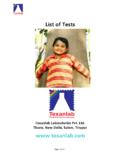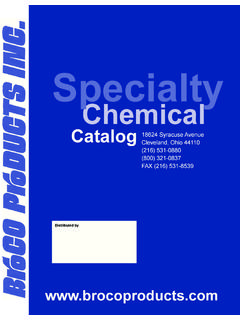Transcription of Coating - galvanizeit.org
1 Preparing Hot-Dip Galvanized Steel for PowderCoatingSeven steps to prepare your next hot-dipgalvanized steel project for powder Coating . 2 American Galvanizers Association Communicate with the Galvanizer ..4 Determine the Condition of the Surface ..5 Newly Galvanized Partially WeatheredClean the Surface ..6 Remove Bumps, Runs, and Drips Remove Organic Contaminants Rinse and Dry Profile the Surface ..8 Sweep Blasting Zinc Phosphate Solution Surface Grinding Bake ..10 Powder Coat ..10 Cure the Powder Coating ..10 Summary ..11 CONTENTS: 2013 American Galvanizers Association. The material provided herein has been developed to provide accurate and authoritative information about after-fabrication hot-dip galvanized steel. This material provides general information only and is not intended as a substitute for competent professional examination and verification as to suitability and applicability. The information provided herein is not intended as a representation or warranty on the part of the AGA.
2 Anyone making use of this information assumes all liability arising from such Galvanizers AssociationDuplex systems, such as paint or powder Coating over hot-dip galvanized steel, have been used for years as a means to enhance corrosion protection. Powder Coating over hot-dip galvanized steel provides the owner/specifier with effective corrosion protection, while still allowing the structure to achieve a desired color or aesthetic. Duplex systems are becoming increasingly common and popular because of this combination of benefits. Additionally, specifiers may opt to powder coat rather than paint to avoid expending the environmentally detrimental volatile organic compounds (VOC s) present in liquid powder Coating over hot-dip galvanized steel is relatively simple. Similar to the paint over galvanizing process, proper surface preparation is key to creating an effective bond between the powder Coating and the galvanized surface. Galvanized steel requires slightly different preparation steps according to the surface condition.
3 Thus, proper preparation relies on correctly identifying the galvanized surface condition, and then following the appropriate cleaning and profiling steps to achieve optimum bonding of the powder Coating to the hot-dip galvanized steel. For detailed instruction on preparing the surface, refer to ASTM D7803: Standard Practice for Preparation of Zinc (Hot-Dip Galvanized) Coated Iron and Steel Product and Hardware Surfaces for Powder Bridge of Lions in St . Augustine, Florida, utilizes a duplex system of powder Coating over hot-dip galvanized (HDG) steel for corrosion protection .Workers prepare the galvanized surface for powder Coating by filing any bumps, runs, or drips created during the galvanizing process .Preparing Hot-Dip Galvanized Steel For powder coating4 American Galvanizers Association The hot-dip galvanized Coating is formed when iron in the steel reacts with zinc in the galvanizing kettle. This metallurgical reaction is a diffusion process, creating a growth of zinc-iron intermetallic layers perpendicular to the steel surface.
4 Zinc, like all metals, is chemically active and when exposed to the atmosphere will attract oxygen, water vapor, and carbon dioxide to its surface to form zinc compounds. The rate of zinc compound formation is determined by a number of variables, including the amount of time since the part was withdrawn from the kettle, the temperature of the part, and the humidity in the a successful duplex system of powder Coating over galvanized steel requires the following seven steps: Communicate with the Galvanizer Determine Condition of the Surface Clean the Surface Profile the Surface Bake Powder Coat Cure the Powder CoatingCommunicate with the GalvanizerCommunication between the fabricator, specifier, powder coater, and galvanizer is vital before galvanizing. The various parties may desire special handling or require alterations to the design to facilitate the galvanizing process and/or the application of the powder Coating . Furthermore, if the galvanizer is aware the part will be powder coated after galvanizing, precautions can be taken to avoid processes that may interfere with the powder Coating galvanizing facilities either immerse the part in a water-quench or passivation bath to cool the parts to facilitate quick handling as well as prevent the formation of wet storage stain.
5 The passivation prevents the formation of excessive zinc compounds, but also interferes with powder Coating adhesion to the galvanized Coating and can lead to blisters and are also two surface imperfections that can inhibit powder Coating adhesion; dross and skimming inclusions. Dross particles are made up of zinc and iron and look like pimples. They are sharp and angular atop the coated surface and tend to protrude through powder coatings and thereby cause adhesion problems. Therefore, dross particles must be ground flat to match the surrounding zinc Coating profile. If it is not possible to grind the Coating flat, the part is not acceptable for powder skimming particles can also attach to the Coating during removal from the zinc bath. Zinc skimmings are particles of zinc oxide that form on the top of the molten zinc bath. Although skimming inclusions are not cause for rejection of the galvanized part, they should be removed before powder notified, the galvanizer can avoid galvanizing processes that could inhibit powder Coating adhesion.
6 5 American Galvanizers AssociationDetermine the Condition of the SurfaceDetermining the condition of the galvanized surface is critical to employing the proper surface preparation. Galvanized surfaces for powder Coating can be classified as newly galvanized or partially weathered. Properly identifying the surface is important because each condition requires a different amount of cleaning and/or GalvanizedNewly galvanized steel has been exposed to the atmosphere for no more than 48 hours and has few zinc compounds on the surface. The Coating can be bright and shiny, indicating an all-zinc outer layer, or matte gray, indicating a zinc-iron intermetallic outer layer, or a combination of both. Whether bright or matte, the key factor in the newly galvanized condition is a lack of zinc compounds on the surface, which simplifies the cleaning. Some newly galvanized parts, those with a matte gray, can have a rough surface texture, while bright and shiny parts are often smooth.
7 Regardless if the surface is rough or smooth, profiling the surface by sweep blasting is necessary to ensure the adherence of the powder WeatheredPartially weathered galvanized surfaces have a build-up of zinc compounds and, possibly, organic contaminants such as dirt, dust, oil, or grease. The compounds become attached to the zinc Coating by electrostatic forces, and can be expected to release from the surface over time. First, the organic compounds need to be cleaned off the galvanized surface. Then zinc compounds, mostly zinc oxide and zinc hydroxide, must be removed before powder Coating . If the parts are stacked too tightly or the humidity is excessive, partially weathered galvanized parts may show signs of wet storage stain. This white powder is created when zinc oxide and zinc hydroxide form a thick layer on the surface. If the partially weathered part shows signs of wet storage stain, the storage stain must be removed before the part can be powder weathered galvanized steel is the most common galvanized surface condition when powder Coating , and also the most difficult to prepare.
8 The partially weathered surface condition is present from two days to about one year after galvanizing, depending on temperature variation and humidity is important to correctly determine the condition of the galvanized surface to be powder coated . Determining the condition of the galvanized surface is critical to employing the proper surface preparation. 6 American Galvanizers Association Clean the SurfaceOnce the condition of the galvanized surface has been properly identified, the next step is to clean the surface. There are three steps to proper cleaning: Remove bumps, runs, & drips (both newly galvanized & partially weathered) Remove organic materials (only for partially weathered) Rinse and dry (both newly galvanized and partially weathered)Remove Bumps, Runs, and DripsThe smoothing step requires the removal of any excess zinc produced when withdrawing the steel from the zinc bath. Small bumps and runs can cause concerns if the part is to be powder coated.
9 As the steel is lifted out of the bath, the liquid zinc drains back into the kettle; however, at times the liquid zinc does not drain quickly enough and freezes to the surface or edge of a part. A run is excess zinc that freezes along the part, and a drip is excess zinc that freezes as it falls off the edge of the part, creating an icicle-like zinc spike. Another surface condition that must be addressed is dross particles. The zinc-iron intermetallic dross particles float in the zinc bath and can be trapped in the outer layer of the Coating . Dross particles are thicker than the Coating and cause bumps or pimples on the surface. All bumps, runs, drips, and dross particles must be smoothed so they will not protrude through the powder Coating . The excess zinc areas (runs, drips, or dross particles) cannot be cleaned by chemical steps so they must be removed by mechanical cleaning such as grinding or filing the surface smooth and flat.
10 The most common practice for removal is to use a hand grinder and lightly abrade away the excess zinc. The grinding and filing must be completed before the chemical cleaning of the part, so the dust and powder from mechanical cleaning can be removed by chemical cleaning. Since pure zinc is a soft metal, care must be taken to remove only the excess zinc material and leave a flat surface without removing the underlying zinc the grinding process removes too much zinc, the grinder will begin to produce sparks, indicating it has reached the base steel. When sparks fly, the Coating must be repaired before powder Coating . Zinc Coating repair methods are described in the specification ASTM A780, Standard Practice for Repair of Damaged and Uncoated Areas of Hot-Dip Galvanized Coatings, and include spray metallizing, zinc solder or repair stick, and zinc-rich icicles created during the galvanizing process must be filed off .Grinding and filing must be completed before the chemical cleaning of a part7 American Galvanizers AssociationRemove Organic ContaminantsOnce the galvanized surface is smooth, the next step for partially weathered galvanized steel involves removing all organic contaminants from its surface.
